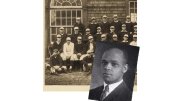On December 22, 2020, Earl Brown ’24 became Harvard’s latest major-league baseball player. That would be Earl Brown, class of 1924, a star pitcher who went on to pitch for the New York Lincoln Giants of the Eastern Colored League. In December 2020, Major League Baseball commissioner Rob Manfred corrected an historical mistake by designating the Negro Leagues as major leagues, making their players major leaguers.
For Brown, who was born in Charlottesville, Virginia, on July 24, 1903, the son of a Baptist pastor and nurse, and started his education in a one-room segregated schoolhouse, professional baseball was a small part of a multifaceted career that included college teaching, journalism, politics, and activism.
Brown came to the College in 1920, and by 1922 was a starting pitcher on Harvard’s second team. Money was tight. He worked summers and holidays as a railroad porter, and some accounts have him playing for the Lincoln Giants in 1923.
Returning in 1924, Brown had a fine season with four wins, capped by a 12-strikeout win against Amherst. Racism intruded when the University of Georgia visited for a two-game series in May. Georgia objected to playing against black players—and Harvard obliged, keeping Brown on the bench for the series. He went on to earn his only “major H” and graduate that spring, concentrating in economics.
That summer Brown had his Major League Baseball-recognized career, a two-game stint for the Lincoln Giants: he went 0-1 with a 7.00 ERA. Other accounts have him playing through the 1926 season; an unfortunate artifact of the racism these players experienced is a lack of verified statistics, but there is a continuing effort to correct this oversight as box scores are discovered and confirmed.
Brown went on report for the New York Herald Tribune and to teach economics at Louisville Municipal College and Virginia Union University before becoming editor of the Amsterdam News. He courted controversy by writing an article in 1940 critical of boxing great Joe Louis for Life magazine. Reaction was swift. Pittsburgh Courier sports editor Chester Washington noted that such articles, “do about as much damage as they do good,” and Brown was fired. Life later hired him as an associate editor.
In 1949 Brown won a seat on the New York City Council, where he investigated police brutality, prompting the commissioner to tighten rules and expand brutality investigations, and helped pass a law forbidding funding of charities that racially discriminated against homeless children. His peak accomplishment was passage of the Fair Housing Practices Law in 1957—the first of its kind in the United States.
Fresh off this victory, Brown took a fateful political step: challenging incumbent Congressman Adam Clayton Powell Jr., in the 1958 Democratic congressional primary. Powell was almost certainly the best-known black elected official in America at the time. But he appeared vulnerable, having been recently indicted for income-tax evasion and provoking the city’s Democratic establishment by endorsing Dwight Eisenhower in the 1956 presidential election. Brown secured support from the Democratic establishment as well as from other parties.
But it was not to be. The tax charges never became an issue, and Powell had his reasons for supporting Eisenhower, charging that the Democratic National Committee “always welcomed back” southern Democrats who voted against civil- rights bills, and that Brown was complicit, “playing Uncle Tom’s game.” Brown lost badly.
Nor did that defeat end matters. Brown had made powerful political enemies; when he was in line for the chairmanship of the New York County Democratic Committee, a largely ceremonial position, J. Raymond Jones, a fellow councilman and Powell’s 1958 campaign manager, successfully opposed Brown’s election. Jones then had Brown ousted from The Carver Democratic Club, a Harlem political organization.
After mayor Robert F. Wagner Jr., appointed Brown deputy Manhattan Borough president, with the expectation he would assume the presidency, Jones stepped up to oppose him. “Anyone except Brown,” he announced. Wagner named civil-rights activist and future federal judge Constance Baker Motley instead (read about Motley in “Both Sides Now,” January-February, page 29). The mayor did appoint Brown head of the Commission on Human Rights, but he retired a short time later. Earl Brown died in 1980.
“Earl Brown gets a lot of bad press,” observes Daniel Soyer, author of The Liberal Party of New York and the Rise and Fall of American Social Democracy, “because he is often viewed in light of his challenges to some of the leading lights of black politics in the city.” Brown, Soyer writes, believed “his brand of politics was more effective than the symbolic gestures that he felt some others were given to.” As evidence, he helped enact important civil-rights legislation, and took his job and political losses without complaint—and without ever backing down.
Adds ESPN analyst and former Major Leaguer (and Penn grad) Doug Glanville, “Brown represents the circuitous route to recognition that people of color face. A man of many talents, he was able to change directions and advocate for the important work that would help counter the forces that limited his opportunity in the first place.”








